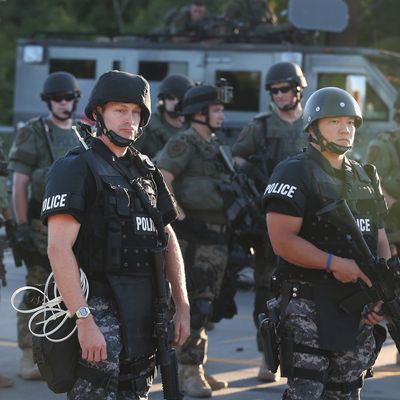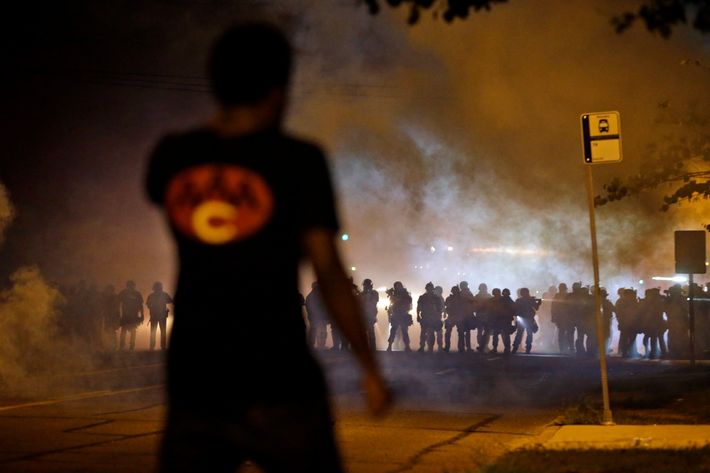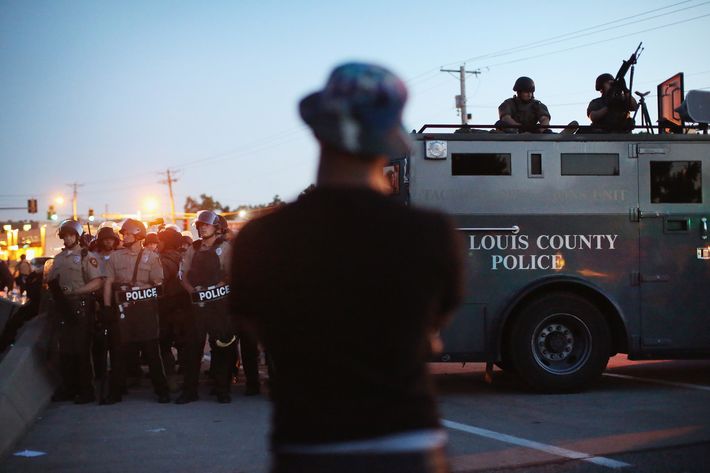
Army fatigues, armored vehicles, tear gas, AR-15s — it’s the war-ready imagery not just of Gaza and Iraq but Ferguson, Missouri, a town of 21,000 with zero murders on the books in 2014. Unless, of course, you count 18-year-old Michael Brown.
The response to protests against the teen’s death at the hands of police turned even more authoritarian when darkness fell on Wednesday, as journalist and citizens alike were targeted with undue force. In night vision, tanks rolling through smoky suburban streets recalled an occupation. But however misguided the show of brute force against the mostly peaceful demonstrators was, it’s a chest-out, guns-up posturing small-time police departments across the country have been preparing for.

Jelani Cobb of The New Yorker described the scene from last night:
What transpired in the streets appeared to be a kind a municipal version of shock and awe; the first wave of flash grenades and tear gas had played as a prelude to the appearance of an unusually large armored vehicle, carrying a military-style rifle mounted on a tripod. The message of all of this was something beyond the mere maintenance of law and order: it’s difficult to imagine how armored officers with what looked like a mobile military sniper’s nest could quell the anxieties of a community outraged by allegations regarding the excessive use of force. It revealed itself as a raw matter of public intimidation.
The instruments of that intimidation have been funneled to local police beginning with the drug war, as laid out by journalist Radley Balko in his book Rise of the Warrior Cop, and a Cato Institute paper on the subject from 2006:
Over the last 25 years, America has seen a disturbing militarization of its civilian law enforcement, along with a dramatic and unsettling rise in the use of paramilitary police units (most commonly called Special Weapons and Tactics, or SWAT) for routine police work. The most common use of SWAT teams today is to serve narcotics warrants, usually with forced, unannounced entry into the home.
These increasingly frequent raids, 40,000 per year by one estimate, are needlessly subjecting nonviolent drug offenders, bystanders, and wrongly targeted civilians to the terror of having their homes invaded while they’re sleeping, usually by teams of heavily armed paramilitary units dressed not as police officers but as soldiers.

The trend only increased as a response to terror after September 11, and more so as the wars in Iraq and Afghanistan wound down. From Adam Serwer at MSNBC:
According to the American Civil Liberties Union, the Department of Defense has transferred $4.3 billion in military equipment to local and state police through the 1033 program, first enacted in 1996 at the height of the so-called War on Drugs. The Department of Justice, according to the ACLU, “plays an important role in the militarization of the police” through its grant programs. It’s not that individual police officers are bad people – it’s that shifts in the American culture of policing encourages officers to ”think of the people they serve as enemies.” […]
Training materials obtained by the ACLU encourage departments to “build the right mind-set in your troops” in order to thwart “terrorist plans to massacre our schoolchildren.” It is possible that, since 9/11, police militarization has massacred more American schoolchildren than any al-Qaida terrorist.
Ferguson specifically was a part of such a program, USA Today reports, having “received advanced rifle sights and night vision equipment between 2012 and 2014”:
Michelle McCaskill, media relations chief at the Defense Logistics Agency, confirms that the Ferguson Police Department is part of a federal program called 1033 that distributes hundreds of millions of dollars of surplus military equipment to civilian police forces across the United States. The materials range from small items, such as pistols and automatic rifles, to heavy armored vehicles such as the MRAPs used in Afghanistan and Iraq.
“In 2013 alone, $449,309,003.71 worth of property was transferred to law enforcement,” the agency’s website states.
As Matt Apuzzo of the New York Times described presciently in June, the broader trend includes sending equipment to towns with no use for it. (The state of Missouri has received seven armored vehicles since 2006.) And much of that gear is provided in a “use it or lose it” arrangement:
Between 2011 and 2012, sixty-three agencies polled by the A.C.L.U. reported that they had received “a total of 15,054 items of battle uniforms or personal protective equipment”; some five hundred agencies had received “vehicles built to withstand armor-piercing roadside bombs.” In many instances, the receipt of these military-grade weapons is contingent on their use within a calendar year.
How necessary is any of this? Well, in February, local Sergeant Matthew Pleviak of St. Louis County’s Tactical Operations Unit SWAT team told the River Front Times, “If you go to any subdivison, there’s grass and trees and bushes.”
But writing for the Daily Beast, a military veteran argued, “The net effect is a Ferguson police department in name only. In terms of its equipment, organization, and deployment methods, the Ferguson force looks more like an infantry or military police company in Iraq … this military gear transforms the police department into an occupying army, and enables the police to act with such speed and violence so as to destroy any meaningful right to peaceably assemble or address grievances towards government.”
Balkey put it this way in a Reddit AMA before Ferguson: “I think that as bad as the weapons and tactics are, the uniforms might be more pernicious, at least in terms of fostering a militaristic mindset.”
“When you dress like a soldier,” he wrote, “you’re predisposing yourself to start thinking like one. And of course, there’s really no strategic value, unless you’re raiding a forest.”





























